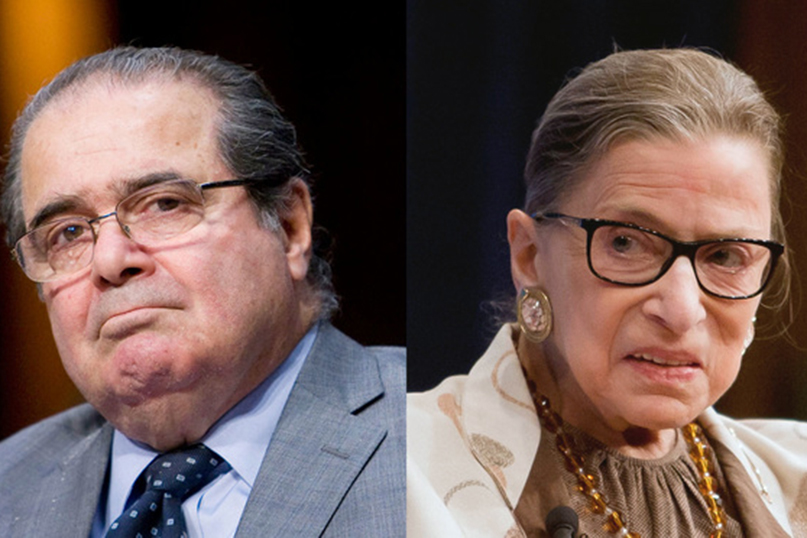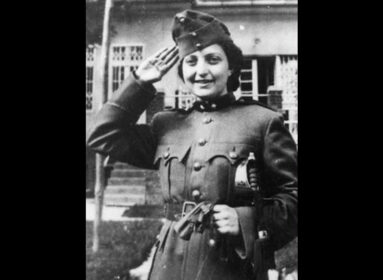
By Jonathan S. Tobin
(JNS) U.S. Supreme Court Justice Ruth Bader Ginsburg, who died on Sept. 18 – the eve of Rosh Hashanah – at the age of 87 was a symbol of female empowerment, as well as a renowned scholar and jurist. Though not religious, she was a proud Jew, and her achievements as an attorney in an era where women were not fully accepted in the legal profession and then as a principled judge justify the many laudatory eulogies about her.
But Ginsburg’s status as a pop-culture icon and idol of liberals, feminists and others, who nicknamed her the “Notorious RBG” after a rap star, made her known popularly in a way no other American judge has ever been. As such, the possibility that President Donald Trump, whom Ginsburg’s many fans detest, naming her successor has added more fuel to the fire of a political conflict that already seemed more like a tribal culture war than a presidential election. But rather than succumb to the temptation to treat political differences as proof of evil, we should be learning from her to embrace our opponents as fellow humans without giving up our principles.
By the time she passed away, Ginsburg had since ceased being merely an honored female pioneer or the intellectual leader of the high court’s liberal faction, as well as an admirable role model for Jewish women and girls. The transformation of a deeply serious and cultured judge into a badass culture-war figure gave her significance that transcended the legal battlefields where she had labored. “RBG” inspired “I dissent” T-shirts, coffee mugs, bobblehead dolls, action figures, coloring books and a character on “SNL” played by Kate McKinnon was a symbol of the “resistance” to political conservatives in general and Trump in particular.
Conservatives like the late U.S. Supreme Court Justice Antonin Scalia believed that the original intent of the framers should dictate how the Constitution should be interpreted. Ginsburg upheld the liberal tradition that took a more activist view of the Constitution as a living document that could change in order to justify what she considered necessary changes.
A secular saint of the political left, her sudden passing has further inflamed divisions in American society. Those who claim to venerate her memory are now threatening to “burn it all down” if Republicans are able to confirm a conservative successor to Ginsburg. Others are threatening to pack the court with liberals should Democrats gain control of the government next year (something Ginsburg specifically opposed) to gain revenge for ignoring what her granddaughter reportedly said was her dying wish to be replaced by the next president, whom she likely hoped would be former Vice President Joe Biden.
There’s plenty of hypocrisy on both sides of the argument about the future of the court. Due to the way Congress has abdicated its responsibilities, the court is the only effective check on the growth of the administrative state controlled by the executive branch. In effect, it is the super-legislature that has more to say about the disposition of key issues than the other branches of government. That struggle to control the court is therefore a life-and-death affair for both parties.
And it has turned Ginsburg’s death into one more excuse for Americans to attack and demonize each other. But it doesn’t have to be that way, and Ginsburg’s own life provides an example of how to return to treating opponents as fellow human beings we can respect and like, even when we disagree with them.
One of the most inspiring stories about Ginsburg is about friendship, not legal combat.
Scalia, whose death in 2016 triggered a previous court controversy, was Ginsburg’s conservative counterpart. Like her, his opinions were intellectual and often fiery critiques of what he considered the flawed thinking of colleagues. On the most contentious issues that divide Americans, Scalia and Ginsburg stood on opposite sides.
In the political culture of America in 2020, such disagreements have become the moral equivalent of religious war in which compromise or even mutual respect is impossible. That’s not how Scalia and Ginsburg looked at it.
The two served as colleagues on the prestigious federal Court of Appeals for the District of Columbia Circuit and were eventually reunited on the Supreme Court. On both benches, they jousted on a host of cases, with neither of them sparing each other’s positions from scorn in their opinions.
And yet, they were also close personal friends.
The two shared a love of opera, which they often attended together. Indeed, their friendship was immortalized in a comic opera called “Scalia v. Ginsburg.” They also loved food, and along with their spouses, shared meals and even traveled together. While their personalities were different – Scalia was more voluble and Ginsburg more reserved – their respect and affection for each other were never in question. No case, no matter how contentious, ever came between them.
How did they do it? And how can society emulate their example?
The answer comes not just from the nobility of spirit that both embodied, but from mutual values that transcended ideological differences. They could care about each other while also disagreeing because of a shared morality.
In his new book titled Morality, Rabbi Jonathan Sachs, former chief rabbi of the United Kingdom, explains that people act in this manner because they see themselves “as part of the same framework of virtues and values, rules and responsibilities, codes and customs, conventions and constraints.”
As Sachs points out, “morality achieves something almost miraculous, and fundamental to human achievement and liberty. It creates trust. It means that to the extent that we are part of the same moral community, we can work together without constantly being on guard against violence, betrayal, exploitation or deception. The stronger the bonds of community, the more powerful the force of trust, and the more we can achieve together.”
This is a powerful lesson that those two judges, each revered by their own side of the political divide, understand intuitively.
The trouble with all too many Americans right now – on both the right and the left–is that they are so drenched with hatred of political opponents that they no longer see them as part of the same community. Those who view things differently are foes not merely to be defeated, but to be delegitimized and destroyed.
Scalia and Ginsburg taught us that we can still be friends while strongly disagreeing with each other. Engaging in civil discourse between left and right may no longer seem possible. Being willing to agree to disagree, and to respect each other’s opinions and credit each other with good motives, has gone out of style with unknowable consequences for the future of American democracy.
We can learn from the two judges that civility and mutual respect don’t require agreement as much as commonalities at the core. Instead of using Ginsburg’s death as an excuse to make these divisions worse with threats and insults, we should be remembering her example and stop demonizing our opponents. May both their memories be for a blessing.
Jonathan S. Tobin is editor in chief of JNS–Jewish News Syndicate. Follow him on Twitter at: @jonathans_tobin.
Main Photo: Supreme Court Justices Antonin Scalia and Ruth Bader Ginsburg.
From camp ‘rabbi’ to pursuing justice: How Judaism animated Ruth Bader Ginsburg’s life
By Ben Sales
(JTA) – In its obituary of Ruth Bader Ginsburg, The Guardian wrote that the late Jewish Supreme Court justice “abandoned her religion.”
That couldn’t be more wrong.
While Ginsburg, who died Friday, Sept. 18, at age 87, was not known for her ritual observance, she spoke frequently about how Jewish values inspired her, and she was active in Jewish causes and with Jewish organizations.
As Ginsburg would note in speeches, she was the only justice with a mezuzah affixed to her office door (presented to her as a gift from Shlamith, a Jewish all-girls school in Brooklyn, New York). A poster on the wall read “Tzedek, tzedek tirdof,” the Hebrew injunction from the Torah meaning “Justice, justice shall you pursue.” She also once wore that line woven into one of her jabots, or collars worn on her Supreme Court robes.
“I am a judge born, raised, and proud of being a Jew,” she wrote in an essay for the American Jewish Committee in 1996. “The demand for justice runs through the entirety of the Jewish tradition. I hope, in my years on the bench of the Supreme Court of the United States, I will have the strength and courage to remain constant in the service of that demand.”
Here’s a timeline of the most Jewish moments and motifs in the life of RBG.
As a teenager, she acted as her camp’s “junior rabbi” and wrote an essay about the importance of remembering the Holocaust.
Ginsburg, raised in Brooklyn and attended the East Midwood Jewish Center, a Conservative synagogue, spent summers she at Camp Che-Ne-Wah in the Adirondacks, where she was unofficially called her camp’s “junior rabbi” and would lead Shabbat prayers.
Barely a year after the Holocaust ended, a teenage Ginsburg wrote an essay in her synagogue bulletin titled “One People” about the importance of a world free of prejudice. She republished the essay in her 2016 book My Own Words.
“We must never forget the horrors which our brethren were subjected to in Bergen-Belsen and other Nazi concentration camps,” she wrote. “There can be a happy world and there will be once again, when men create a strong bond towards one another, a bond unbreakable by a studied prejudice or a passing circumstance.”
She was disillusioned with Jewish observance at age 17 when women weren’t counted in a prayer quorum at her mother’s shiva.
Presaging her pioneering work for women’s rights, Ginsburg would relate that she stopped feeling connected to Jewish ritual at 17 because of the absence of a minyan at her mother’s shiva, as women were not counted. Even though there was “a house full of women,” she said in a 2008 speech at Washington, D.C.’s Sixth & I Synagogue, no prayer was held because 10 men were not present.
In her college dorm, she felt discriminated against when all the Jewish women were placed on the same floor.
In her freshman dormitory at Cornell University (from which Ginsburg graduated in 1954), Ginsburg discovered that she and the other women in her corridor were all Jewish. She told a documentary she felt that they were placed together “so we wouldn’t contaminate” other students.
She sent their kids to Hebrew school.
Speaking to the Jewish Telegraph Agency in 1993, when Ginsburg was nominated for the Supreme Court, her husband, Martin Ginsburg, described the family as “not wildly observant,” though he said they went to a traditional Passover Seder with relatives. Later in life, in 2015, Ginsburg co-authored a feminist reinterpretation of the Passover story with Rabbi Lauren Holtzblatt.
The Ginsburgs sent their kids to Hebrew school when they lived in the New York area, but Martin Ginsburg told JTA that they didn’t join a synagogue when they moved to Washington, as the kids had grown up.
She visited Israel in the 1970s for a conference on Jewish law – and kept going back.
As an attorney, while arguing a series of landmark women’s rights cases before the Supreme Court in the ’70s, Ginsburg also “actively participated” in the American Jewish Congress’ Commission on Law and Social Action. Also during that decade, she attended a conference in Israel discussing the position of women under secular and halachic laws in Israel and America.
For decades after that trip, Ginsburg continued to travel to the country and comment on its legal system. In 2000, she was honored along with other American and Israeli Jewish feminists at the Knesset. Five years later she was part of a group that advised Israel not to adopt an American-style constitution because it would give the country’s judges less freedom. At an event on that subject, she said, “I admire Israel and I admire Aharon Barak,” Israel’s former chief justice.
More recently, in 2017, she received a lifetime achievement award from the Genesis Prize Foundation in Israel. She was supposed to receive the Genesis Prize itself, known as the “Jewish Nobel,” but declined because she feared that the $1 million cash prize could violate ethics laws.
When a soldier wanted to wear a kippah in the military, Ginsburg stood up for him in court.
In 1984, S. Simcha Goldman, a Jewish soldier, fought in court against a military policy that banned him from wearing a yarmulke on duty. Ginsburg’s appeals court declined to hear his case, but Ginsburg dissented from that decision.
“A military commander has now declared intolerable the yarmulka Dr. Goldman has worn without incident throughout his several years of military service,” she wrote. “At the least, the declaration suggests ‘callous indifference’ to Dr. Goldman’s religious faith.”
In her confirmation hearings, she spoke about how her Jewish heritage impacted her views.
Appearing before the Senate in 1993, Ginsburg said her ancestors “had the foresight to leave the old country when Jewish ancestry and faith meant exposure to pogroms and denigration of one’s human worth.” During questioning, she spoke about how country clubs would bar admission to Jews and said, “One couldn’t help but be sensitive to discrimination, being a Jew in America during World War II.”
She stayed involved in Holocaust remembrance.
Ginsburg was active with the U.S. Holocaust Memorial Museum. In 1993, months after she joined the court, she presented the museum’s Medal of Remembrance to Emilie Schindler, widow of Oskar Schindler, whose story of rescuing Jews during the Holocaust had recently been told in the film “Schindler’s List.”
In 2004, she gave a speech at the museum on Holocaust Remembrance Day on the role of the law in preventing atrocity. “In striving to drain dry the waters of prejudice and oppression, we must rely on measures of our own creation – upon the wisdom of our laws and the decency of our institutions, upon our reasoning minds and our feeling hearts,” she said. “And as a constant spark to carry on, upon our vivid memories of the evils we wish to banish from our world. In our long struggle for a more just world, our memories are among our most powerful resources.”
She presided over a mock trial of Shylock from “The Merchant of Venice.”
Alongside a staging of the Shakespeare production, Ginsburg presided over a mock appeal of the guilty verdict given to Shylock, the play’s main character and an infamous anti-Semitic stereotype. The event was held to celebrate the 500th anniversary of Venice’s historical Jewish Ghetto. Ginsburg’s courtroom, unlike Shakespeare’s, found in Shylock’s favor.
Her granddaughter called her “Bubbie.”
Her granddaughter, Clara Spera, gave a more personal perspective on the Supreme Court justice in a 2018 essay: “You may know her as Justice Ruth Bader Ginsburg, or affectionately as the Notorious RBG, but to me she’s Bubbie,” Spera, herself a lawyer, wrote in Glamour. “Bubbie with whom I spend most High Holy Days. Bubbie who took me to see ‘The Book of Mormon,’ where we both laughed until we cried. Bubbie who loves going to the movies. Bubbie at whom I get a kick out of poking fun. Just a Bubbie like any other.”








 Southern New England Jewish Ledger
Southern New England Jewish Ledger









